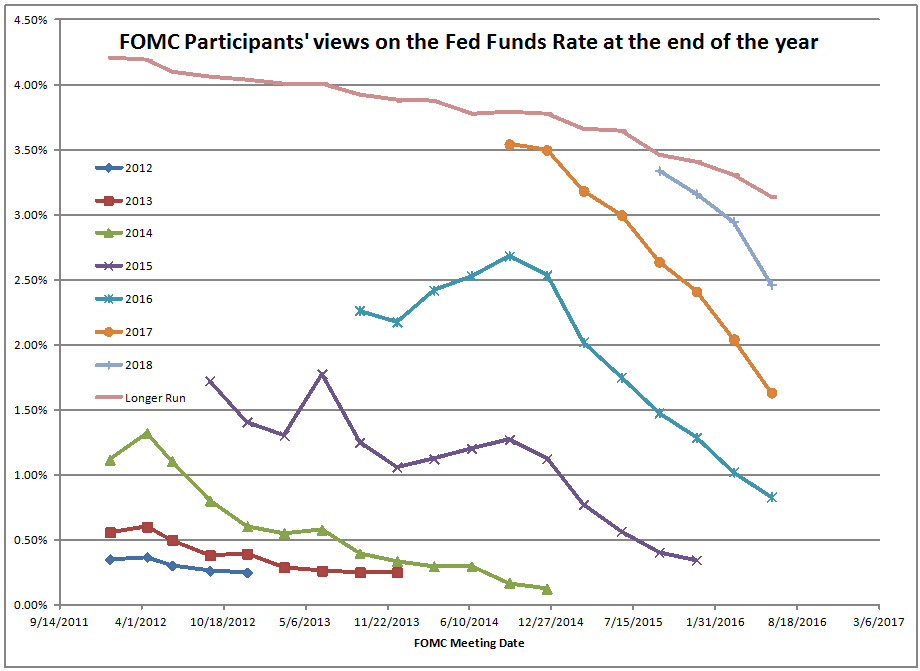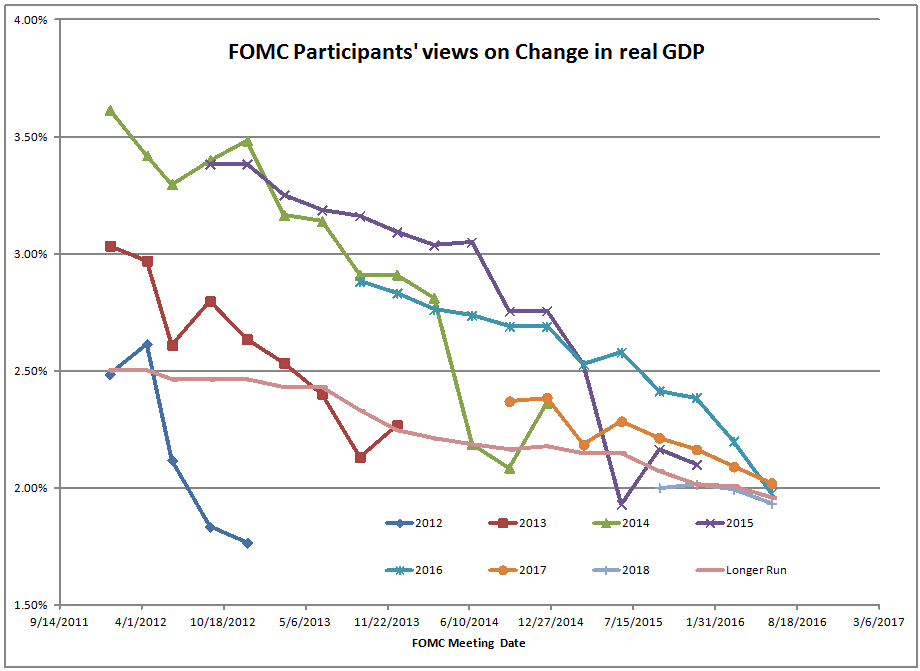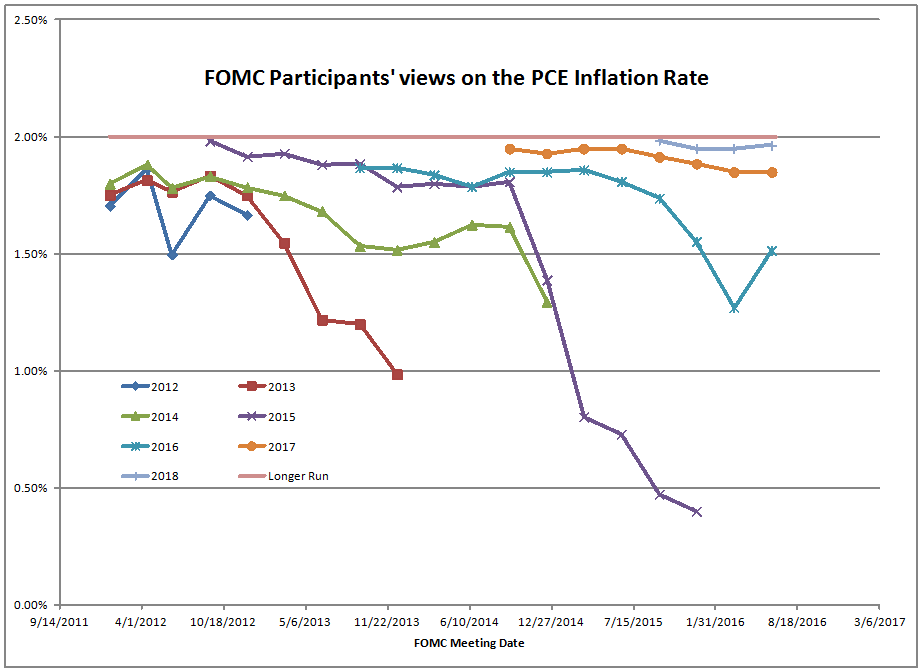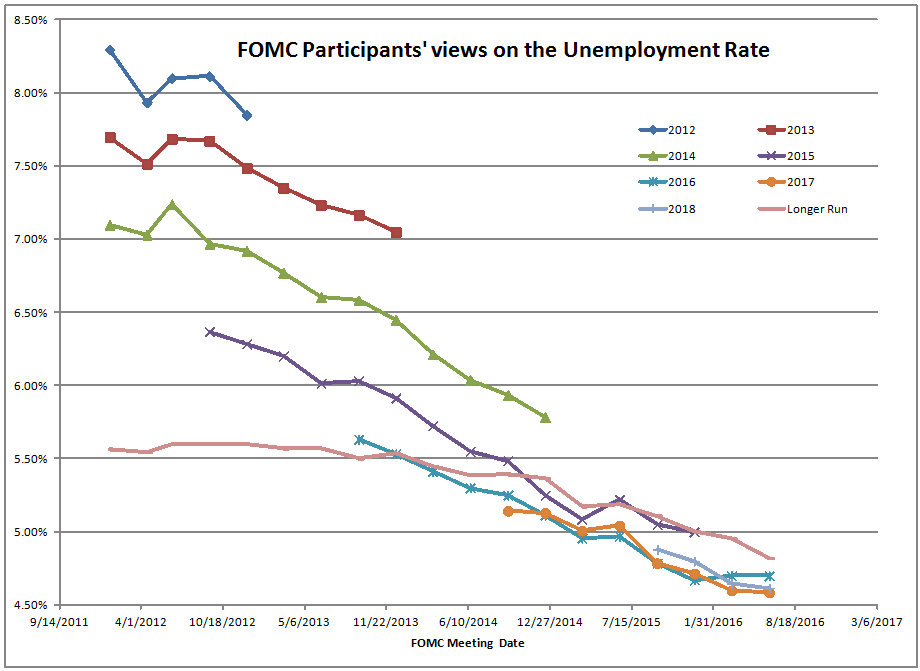
When do you admit that you are wrong? ?Do you do it publicly? ?Do you hide it?
Do you hide it plain sight?
When I look at the graph for Fed funds for 2017 and later, I think the FOMC is admitting that they were wrong for a long time, and now hide that in plain sight.
They don’t admit that they were wrong. ?They don’t admit that the economy has proven to be a lot weaker than they ever expected, and that they now expect that to persist for a while.
That’s what the graphs for Fed funds and GDP say.

But what does the FOMC say in its statement? ?It expresses confidence in future GDP robust growth, even though their expectations have collapsed to 2% real growth as far as they care to opine.
Look at the above graph, and see how it has all converged to 2%.

PCE Inflation? They assume it will be 2% before the year starts, and then they adapt to incoming data.
There’s no model here, just a disappointed ideology that says they wish to ?produce a 2% PCE inflation rate, dubious as that goal is.
The only thing more dubious there is their ability to achieve their ideology.

Remember after the financial crisis? There were those who said unemployment would never return to 5% — that the natural rate of unemployment was permanently higher.
I may have been among them.
Well, now the FOMC has a new consensus. ?Unemployment below 5%?as far as they care to opine.
When I look at these graphs, particularly the ones for Fed funds and GDP growth, I see a paradigm shift where Bayesian priors have been dragged kicking and screaming by the data to No Man’s Land.
Grudgingly they acknowledge the data in the graphs, but they don’t have a theory to go along with it, so their statements and minutes sound the same.
Nothing is changed. ?Soon our policies will restore robust real GDP growth, produce inflation and then we will tighten policy and restore normalcy.
Well, that’s what their minutes and statements say.
But who are you going to believe? ?The FOMC and their words, or your lying eyes looking at their graphs?
PS — modified to reflect Bullard’s lack of a vote on long-term Fed funds rate.

I have to admit, as a semi-educated observer, the Fed has seemed delusional to me for the past couple years, though not in the ways that most people express it. I generally support the Fed, and think the response to 2008 was strong and very much needed/appropriate. However, I think they’ve been drifting since about 2010/11. I believe that there is a huge disincentive to increase wages among US companies, and IMHO, it’s just not going to happen anytime soon. I also believe there is a huge and long-running WW deflationary trend that means US Inflation is not going to happen anytime soon. I’m usually not a ‘one big idea’ forecaster, usually forecasting accuracy is the result of absorbing and sifting a lot of relevant data. I’m sure I’m overly simplistic and think I understand more than I really do, and yet I can’t help but believe that the Fed is engaging in avoidance behavior, as your charts might be interpreted to indicate. I make financial forecasts as part of my everyday job, and I know how much emotion most people put into the exercise – there aren’t many people that can put aside their biases long enough to let the facts tell the story. In this case, I think the Fed has a vision of where the economy is supposed to be right now, what it’s supposed to look like, and they are leaning too heavily on that vision to inform their outlooks.
FOmc should study Steve keen, which would inform them of
A) banks are not intermediaries, they create new money when they credit borrowers accounts
B) when private sector debt grows faster than national income (gdp), as occurred during the 70’s oil shocks, debt eventually reaches a level where income is barely sufficient to cover payments. In this case a recession is a serious event because the decline in national income instantly leads to waves of defaults. The partial response, I.e. Saving the banks, was necessary but not sufficient; defaulting home loans should have been bought and homeowners offered the option of reduced payments and eventual partial ownership… No need for fiscal policy.
As an aside, it would be nice if the fed would also learn from the failure of its massive and repeated QE to induce inflation, that friedman’s ‘inflation is always and ever a monetary phenomenom…’ Is now demonstrably false, and revert to the understanding that inflation is always and ever the result of the supply of, and demand for, the good in question.
But such recognition by such worthies amounts to admission of a lifetime of wrong views and unnecessary suffering of many millions, here and abroad, earlier in the Asian crisis and, far worse than here, in the disaster named EU. Why, one might as well bet on a revolution, such as the one advocated by that socialist sanders, trying to fight the combined FIRE and military industrial complex’ beloved standard bearer… How absurd.
Thanks for sharing this, David. I thought it was very insightful. It’s amazing how in plain sight, we can see how continued failure to meet expectations drives further and further downward revisions. I like to think we all would like to say that when we are wrong, we would come right out and say it. But (as you know) since we are living in a time where the market hinges on every word and data point said publicly by the fed, it’s difficult for them to change course. For the sake of the market, I hope something is done to reverse this cycle without bringing us to another economic collapse. I’m not one to make macro-economic forecasts, I’m just one to interpret the decisions they make and hope they make the right ones. Thanks for the information!